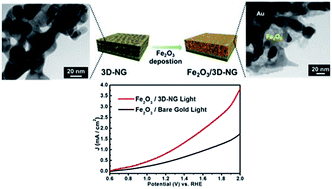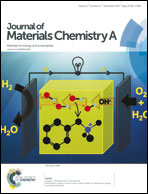Efficient photoelectrochemical water splitting of nanostructured hematite on a three-dimensional nanoporous metal electrode†
Abstract
We report great enhancement in photoelectrochemical water splitting efficiency of hematite assisted by fast and easy transfer of electrons/holes via a 3D-nanoporous gold (3D-NG) electrode. 3D-nanostructured α-Fe2O3/NG electrodes were fabricated in three subsequent procedures, de-alloying Au/Ag to produce a conductive 3D-NG electrode, decorating nanocrystalline β-FeOOH onto the nanopores of 3D-NG via a hydrothermal method, and converting β-FeOOH into α-Fe2O3. α-Fe2O3/3D-NG exhibits a maximum photocurrent density of 1.6 mA cm−2 at 1.5 V vs. RHE under AM 1.5 G simulated sunlight illumination via a photocatalytic hydrogen generation reaction, which is 2 times greater than that of the unmodified α-Fe2O3 photoanode. Incident photon-to-electron conversion efficiency (IPCE) and electrochemical impedance spectroscopy (EIS) data confirm that α-Fe2O3/3D-NG suppresses electron–hole recombination. The excellent performance of nanostructured hematites on 3D-nanoporous metal electrodes makes them promising candidates as electrodes with maximum efficiency in water splitting.


 Please wait while we load your content...
Please wait while we load your content...